Main Menu
Welcome
Fittingly enough, the exhibition started with a piece from the Documenta 8, the movie "Der Lauf der Dinge" (the way things go):
As you can see, the video shows a long sequence of various mechanical and chemical cause-and-effect sequences, a chain reaction. Some of these sequences are difficult to comprehend and believe without some basic chemistry and physics. The intricacy of the design is impressive and the whole sequence does make one think about determinism in the macroscopic world. It made me reflect about my own work on spontaneous behavior, which, while not uncaused (it's caused by a biological mechanism in the animal), lacks the external sensory trigger which is commonly taken for granted.
The next piece was something for all senses: an old cement mixer, refurbished to roast popcorn:
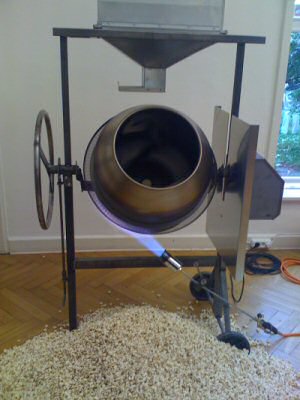
When it was running, the machine was loud, the entire museum smelled of popcorn and if you wanted, you could eat the freshly popped corn. A very ironic way of fusing the sensations during the procedure with associations one has with the original purpose of the machine and with the smell and taste of the popcorn.
The third object was a very fragile-looking piece, seemingly cobbled together from what the artist had standing around:
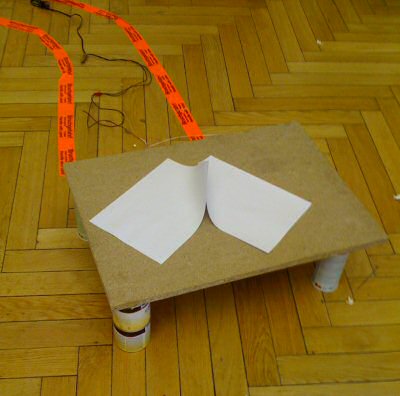
It was not the first time I was really angry that the iPhone 3G can't record videos! What you can't see on this picture is that the sheets of paper are rotating against one another such that they are always pushing against each other. This arrangement elicited the most peculiar impression and was surprisingly aesthetic. We even thought we could build something like this (maybe with light) for the livingroom... beautiful.
The next piece was the one that captivated me the most. For me it embodied the essence of 'romantic machines'. It's "Time Machine" (there's also video on that page) by Robert Barta:
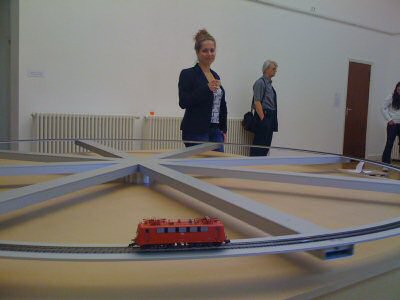
There is a small, red electric locomotive (which so reminded me of "the little engine that could") running on a big horizontal wheel. The wheel is rotating at such a speed, that the engine is basically at a standstill, with reference to the room. The wheel and the train are both symbols for some of humanity's greatest inventions, yet the tiny engine on the gigantic wheel feels like almost a Metropolisian allegory of insignificant beings running as fast as they can only to stay where they are. Talk about a romantic machine! The little engine also reminded me of today's scientists struggling to balance experiments, teaching, writing and conference traveling just to get from one short-term-contract to the next in this publish-or-perish world.
A very dynamic exhibit was O2 by Zilvinas Kempinas. There was a fan which kept a loop of magnetic tape (video recording tape) hovering on the wall. Whenever your hand got into the airstream, the loop changed shape, seemingly alive. This video is pretty similar:
I was mesmerized at the sight of the hovering band and felt why it fitted very well into the category of 'romantic machines'.
The next exhibit that invited me to stop and think was a mirror my Johanna Smiatek. This mirror would start to vibrate when you got too close, making it impossible to discern any details any more. This one was reminiscent of Narcissus, who fell in love with his image in a pool. If you get too close to the surface and touch it, you also destroy the image.
The technically most advanced exhibit was the bit.reflection installation by Julius Popp of bit.fall fame:
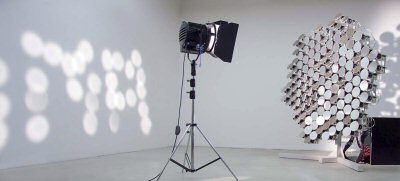
The mirrors reflect the light onto the wall and form words, pulled from news-sites on ther internet. At first, only a few letters appear, then the whole word, which quickly becomes illegible as it's transformed into the next word. Very much like bit.fall, it captures nicely the ephemeral nature of news these days. For a few media cycles, something incredibly impressive or important happens, reverberates in the various media, only to be dropped and forgotten and sometimes destroyed soon after. You can find videos here and here which show the machine working in grerat detail. The video below shows several Julius Popp pieces and starts bit-reflection at 2:57.
On the outside, in a wall separating two parts of a central yard, is a bee-hive from Bärbel Rothaar:
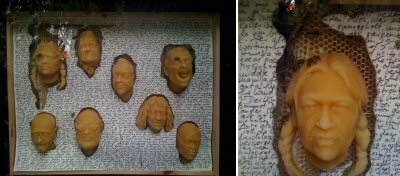
Working at an institution where most people work on honeybees, this was of course of particular interest to me. The piece sits in front of a webcam, so you can see a few videos of the bees buzzing away here.
It seems, science and technology have now become so dominant in our culture (this sounds almost like I think it's a bad thing!
 , that the arts are increasingly drawing inspiration and topics from them. Art is always also a method of answering the questions of who and what we are. In that respect, it is akin to science. Maybe the cross-fertilisation seen between them is not all too surprising. Maybe it is more surprising the transfer seems to be going only in one direction, or isn't it? I often find that the scientific and the artistic method often complement each other very well, finding different perspectives on similar answers. Certainly, my science dominated (it's basically a monopoly!) life would be seriously impoverished without this alternative, artistic perspective.
, that the arts are increasingly drawing inspiration and topics from them. Art is always also a method of answering the questions of who and what we are. In that respect, it is akin to science. Maybe the cross-fertilisation seen between them is not all too surprising. Maybe it is more surprising the transfer seems to be going only in one direction, or isn't it? I often find that the scientific and the artistic method often complement each other very well, finding different perspectives on similar answers. Certainly, my science dominated (it's basically a monopoly!) life would be seriously impoverished without this alternative, artistic perspective.The exhibition will be on until September 6 and if you're in Berlin and are the least interested in these sorts of things, have a look, we had a great time there.
Posted on Monday 29 June 2009 - 16:13:53 comment: 0
{TAGS}
{TAGS}
You must be logged in to make comments on this site - please log in, or if you are not registered click here to signup
Render time: 0.1076 sec, 0.0069 of that for queries.





